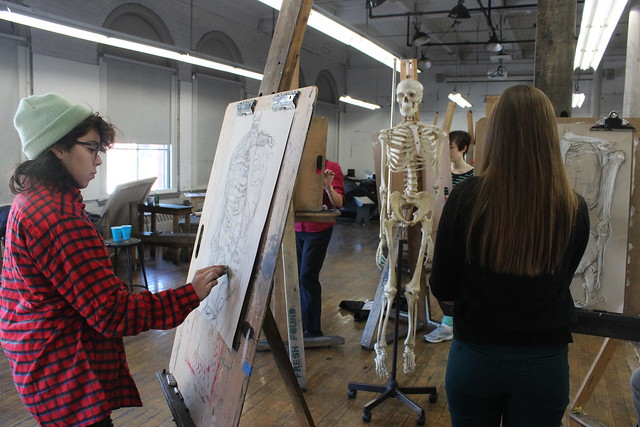This summer I’m teaching 5 classes of Drawing Foundations and Design Foundations in the RISD Pre-College program. Every year, every class is distinct, and offers a different set of challenges for me. Despite how unique every student is, there is one universal problem that I see across the board in all of my pre-college classes: when students stop working on their projects too early. The majority of student artwork I’ve seen in the past few weeks is off to a good start, but is noticeably unresolved because students stepped away from the work prematurely.
This tendency to leave an artwork early is understandable; many art students fear that if they work on their projects for too long, they will ruin it. Their desire to protect the final results in order to ensure a certain degree of success shuts down their willingness to take creative risks. Consequently, many art student miss out on opportunities that might have arisen if they had just given their project another hour.
Creating an artwork is a roller coaster ride where nothing is guaranteed. Many art students have an unrealistic expectation that an artwork should improve in a linear manner, and that if they hit a rough patch that the apocalypse has arrived and nothing in their project can be salvaged. On the contrary, I’ve witnessed students kill their projects and then resurrect the artwork later. I’ve seen students dig themselves out of seemingly hopeless situations and emerge with outstanding results.
Learning how to bring an artwork to true completion is one of the most important skills to gain as an artist. If you are running a marathon and drop out at mile 15, it doesn’t matter how far ahead you were at the beginning because you didn’t finish the race. I tell my students that no matter how flawed or unpleasant their process was, to make sure that they cross the finish line.
I once had a student who struggled enormously with the craftsmanship of a collage project. He was extremely frustrated and clearly had no experience with the materials: there was glue everywhere, finger prints, the paper wasn’t cut cleanly, etc. However, his piece fundamentally demonstrated that he developed a strong grasp of composition through the piece, which was one of the primary objectives of the assignment. His composition was dynamic and spacious. Although this student’s technical execution of the materials was a complete car crash, he still followed through and finished the piece. He was mortified at the critique by his poor technique, and was shocked when I commended him for his efforts. I have tremendous respect for the fact that he kept working on the piece, despite his awareness of how sloppy his technique was. It’s never fun to work on a project that you know isn’t going well, and I commended the fact that he pushed through and finished the race.
The difficulty is that there is no “correct” way to finish an artwork, so how do you know what is truly finished? To figure this out, I encourage my students to intentionally overwork their pieces. This can be a painful, as you can easily lose good parts of your piece in the process, and the results are not always pretty.
I had a RISD student who worked on a charcoal drawing to the point that the surface of the paper started to deteriorate. She was up all night working, and was extremely frustrated that nothing was progressing. When she brought the drawing in for the group critique that morning, it looked like a a civil war had been waged on her drawing. This was the worst drawing she did all semester, but she told me later that the experience was tremendously valuable. She had pushed the drawing well beyond what she thought was reasonable. Since she went too far with that drawing, she had a better understanding of where her limits were, and was able to pull herself back for the next assignment. I tell my students to let one of their assignments be a “sacrifice drawing,” where they give up any intention of creating a successful piece, to figure out where their limits are.
If you’re an art student, stay with your pieces. Something amazing might be just around the corner, but you’ll never find it if you get up and leave. Sometimes just 60 minutes is all the difference in the world.
ART PROF is a free, online educational platform for visual arts for people of all ages and means. artprof.org features video courses, art critiques, an encyclopedia of art supplies, and more.
PORTFOLIO VIDEO CRITIQUES
Prof Lieu offers video critiques on portfolios for students applying to art school and working artists. More info.
ART DARES
Every month, we assign a topic for you to respond to with an artwork. We give out prizes in several categories! More info.
ASK THE ART PROF was a written column in the Huffington Post from about art related topics. Visit our Pro Development page.




how true those words, I am not a formal student, and as such I have chosen to teach myself. Painfully slow process, but i have discovered the same findings